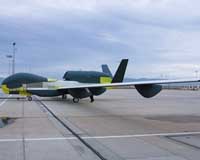| . |  |
. |
San Diego CA (SPX) Aug 11, 2009 Northrop Grumman's RQ-4 Global Hawk unmanned aircraft system (UAS) recently reached a major milestone - 25,000 combat hours - during an operational sortie July 8-9 from a deployed location. "This is a significant program achievement, accounting for more than 76 percent of the aircraft's 32,500 cumulative flight hours for the U.S. Air Force and U.S. Navy," said George Guerra, Northrop Grumman vice president of high-altitude, long-endurance (HALE) systems. "We have been flying Global Hawks more effectively than any other deployed system and our production team continues to perform exceptionally well, with the 26th production air vehicle in final assembly. At this rate, we'll be on the road to completing initial operational test and evaluation to support a full-rate production decision next year." First flown in 1998, Global Hawk has logged 1,229 missions so far in support of Overseas Contingency Operations (OCO) and disaster relief efforts. It has seen service in Operations Enduring Freedom (Afghanistan) and Iraqi Freedom, and in several U.S. and international joint forces exercises. It has also provided support during Hurricane Ike and California wildfires. In addition, Global Hawk's proven and unique capabilities to fly at high altitudes and cover large areas for long periods of time led the Air Force to recently select the Block 20 configuration for the Battlefield Airborne Communications Node (BACN), an airborne communications system that will provide warfighters with critical real-time battlefield information. Tasking under the Joint Urgent Operational Need includes installing BACN on two Block 20 Global Hawk unmanned aircraft, which enable around-the-clock coverage. "Global Hawk has been a constant companion for our men and women overseas, providing persistent intelligence, surveillance and reconnaissance for nearly eight years," said Steve Amburgey, Global Hawk program director for the 303d Aeronautical Systems Group at Wright-Patterson Air Force Base, Ohio. "The system is so robust and reliable that it's in high demand by our warfighters who fly them approximately six to seven days a week, averaging more than 600 hours per month in theater." As the world's first fully autonomous HALE UAS, Global Hawk can soar at altitudes of more than 60,000 feet for more than 32 hours and send near-real-time reconnaissance imagery to air, ground, and sea forces. It can fly three times as long and operates at a fraction of the cost per flight hour than its manned counterpart. Compared to other similar UAS, it only takes a single Global Hawk to collect the same information as 18 smaller medium-altitude UAS. To date, 33 Global Hawks have been assembled, including the two for the Navy's Broad Area Maritime Surveillance Demonstration program, seven advanced concept technology demonstration aircraft built under the original development program sponsored by the Defense Advanced Research Projects Agency, and one Euro Hawk for the German Ministry of Defence. Share This Article With Planet Earth
Related Links Northrop Grumman UAV News - Suppliers and Technology
 Euro Hawk UAV Completes Structural Assembly For Germany
Euro Hawk UAV Completes Structural Assembly For GermanySan Diego CA (SPX) Aug 07, 2009 Northrop Grumman has finished assembling the first Euro Hawk unmanned aircraft system (UAS) for the German Ministry of Defence (MoD). With a wing span larger than a commercial airliner and endurance projected at up to 30 hours, the Euro Hawk will serve as the German Air Force's high-altitude, long-endurance signals intelligence (SIGINT) system. The Euro Hawk is a derivative of the Block 20 ... read more |
|
| The content herein, unless otherwise known to be public domain, are Copyright 1995-2009 - SpaceDaily. AFP and UPI Wire Stories are copyright Agence France-Presse and United Press International. ESA Portal Reports are copyright European Space Agency. All NASA sourced material is public domain. Additional copyrights may apply in whole or part to other bona fide parties. Advertising does not imply endorsement,agreement or approval of any opinions, statements or information provided by SpaceDaily on any Web page published or hosted by SpaceDaily. Privacy Statement |